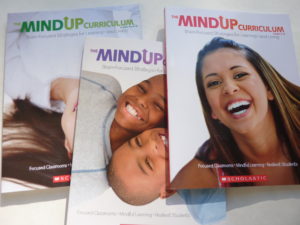What is the MindUp Curriculum?
We are fortunate to be in the exploding era of brain research. Researchers now know so much more than they did just ten years ago, and this information is available to children as young as pre-school age (3-4 years)! Imagine learning about the brain when we were in pre-school! Goldie Hawn has made this possible with her vision and creation of MindUp. MindUp is a school-based program that teaches Mindfulness to students from pre-school age to grade 8 (age 13 years). MindUp is being implemented in many schools all across Vancouver.
Mindfulness gives kids a tool for understanding how their brain works, for having more self-control ~ Goldie Hawn
What Do Children Learn in the MindUp Program?
- How their brains work
- Focused awareness by taking part in breathing exercises a few times/day
- How to be mindfully aware using all the fives senses and mindful movement
- Perspective taking
- Choosing optimism
- Appreciating happy experiences
- Expressing gratitude
- Performing acts of kindness
- Taking mindful action in the world
What Are the Effects of a Mindfulness-Based Educational Program?
These are the findings according to researchers, Schonert-Reichl & Lawlor (2010):
- Children exhibited improved optimism and self-concept
- Children evidenced improvements in social-emotional competence and decreases in aggression and antisocial behaviours
- Students’ response to the MindUp program showed acceptance of and interest in the program
- Children learn to focus their attention and develop a more positive outlook on school. Students were significantly more attentive and emotionally regulated.
- Teachers see and experience positive gains in the classrooms (For example, a 15% rise in students’ math achievement)
- Teachers feel better about teaching as a profession and their jobs
What is the definition of Mindfulness?
The awareness that emerges through paying attention on purpose, in the present moment, and nonjudgmentally to the unfolding of experiences moment by moment ~ John Kabat-Zinn
How Can We Teach Ourselves and Our Children to Be More Mindful?
Being mindful involves three parts:
1) It is an active process – active attention which leads to awareness
2) It focuses on the present rather than the past or the future
3) It requires nonjudgmental thought, and acceptance without thinking that the present moment is good or bad, right or wrong etc.
The goal of mindfulness is to have increased awareness of the present moment and to be accepting of whatever state the body and mind are in.
Whatever you are doing, ask yourself, “What’s the state of my mind? ~ Dalai Lama
How Can I Train Myself to Spend More Time in the Present?
Have you ever noticed how you’ve driven from one destination to another and can’t remember how you got there? Have you ever gone for a walk with a friend and started planning your upcoming weekend? We get in the habit of living our life in auto-pilot or in the past or future.
Begin with the external environment. Pay attention to your five senses to stay in the moment. How does your food taste? What is the temperature of your environment? What can you smell or touch? Anxious people tend to worry about the future, depressed people tend to ruminate in the past, therefore one can see how staying in the present is a gift. We can feel more peaceful if we can focus on just being – human BEings.
Next week, I’ll continue with Part II of becoming more mindful.
Have a wonderful week paying attention to all your fives senses and noticing the present moment,
Warmly,
My 6 Top Apps for Creating More Calm for You and Your Children!
Want to Connect?
Subscribe now to receive free weekly parenting tips and inspiration.









2 thoughts on “Are you Mindless, Mind “full” or Mindful? How MindUp Can Help…”
Comments are closed.